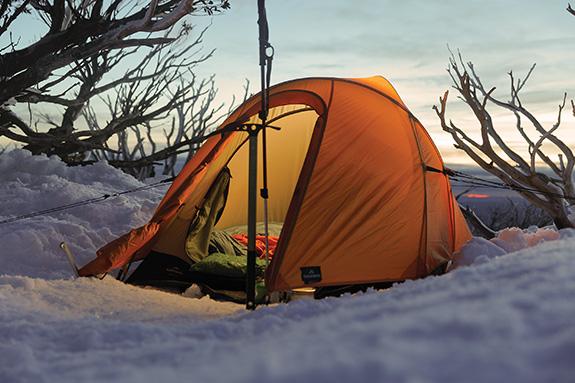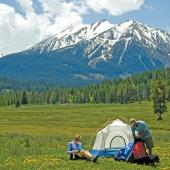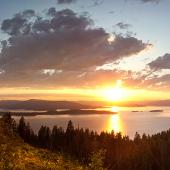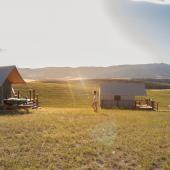Negate the Nightmare
Helpful hints for winter camping.
From exceptional icefalls for climbing to vast expanses for backcountry skiing, southwest Montana is a hallowed winter-recreation destination. Winter camping is not one of those destination activities. It’s cold, wet, and you may have to posthole to a campsite, where you’ll need to melt snow to get a drink of water. But once you get past these challenges, having the woods to yourself makes it worth the effort. Plus, winter-camping skills come in handy for epic ski objectives or ice-climbing overnights. With careful planning and the right gear, it can be a new way to enjoy the backcountry throughout the long Montana winter. Here are some ways to more comfortably enjoy the magic of the winter woods.
Be Smart About Your Campsite
Bury tent stakes horizontally using a “deadman anchor,” or opt for a set of beefed-up snow stakes. Aim for a site with shrubs or trees on at least one side for a windbreak, and a flat tent spot with a good cushion of snow. Compress the snow as much as possible before tent setup, and look out for hazardous branches or potential treefall. And of course, never set up in an area beneath a slope with slide potential.
Stay (As) Dry (As Possible)
Don’t overdress for the hike. You’re going to start cold and warm up once your heart rate accelerates. When you start to sweat, remove excess layers. At camp, remove hiking layers and put on dry camp clothes before you get chilled. It’s harder to warm up than to stay warm. Essential layers include a wicking baselayer, a fleece or wool midlayer, a down or synthetic insulation layer, and a waterproof shell. Camp clothes are a must, including a pair of thick socks.
Plan Your Fuel (and Fueling) Strategy
Melting snow uses more fuel than boiling water—bring an extra fuel canister. Remember that your body needs more calories for over-snow travel and to stay warm when stationary. It’s also tough to remember to hydrate in cold weather, so remind yourself to drink! If you choose a canister stove, keeping the fuel in your jacket pocket around camp or in your sleeping bag at night will help it burn more efficiently. Leave your water bottle in your sleeping bag overnight while you’re at it. Waking up to a block of ice in the Nalgene is demoralizing.
Bring the Right Winter-Camping Kit
Don’t head into the backcountry without knowing your layering strategy, the temperature ratings of your sleep system, and the capabilities of your tent. Be sure your sleeping bag is rated for projected temperatures. Bringing the right sleeping pad is also crucial. Many winter campers bring two: a closed-cell foam pad to insulate from the ground, plus an inflatable pad with an R-value of at least four. A reasonably sturdy three-season tent will typically work fine for non-technical backcountry camping, but a four-season model won’t hurt.
Keep Your Gear Dry
In powdery snow and dry weather, this isn’t terribly difficult, but it gets tougher in slushy or damp conditions. Hang your sleeping bag from a tree, or bring a trash contractor bag for a ground cloth. Keeping your down dry is especially important. If you’re worried about damp conditions, choose hydrophobic down or a synthetic sleeping bag. Synthetic is less packable than down, but not worrying about saturation can be worth the extra weight. Venting your tent is also important—condensation builds when warm air can’t escape. Keep the fly pulled tight, but leave the zipper partially open and pay attention to where your vents are facing.











